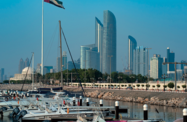The year 2010 will be remembered in Abu Dhabi for the local government forging ahead with a counter-cyclical spending regime aimed at boosting the economy and buttressing the Economic Vision 2030.
The Union Railway, a nationwide rail project, offers a good example of this. In early September, bidding began for the first round of lucrative packages related to the planned UAE-wide link. It was seen as a sign of the government’s commitment to carrying on with plans hatched before the crisis.
Over the medium to long term the project is expected to help create a thriving small- and medium-sized enterprise (SME) sector in Abu Dhabi and the wider UAE for businesses specialising in locomotive supplies, maintenance and manufacturing.
In addition, the railway is also going to play an important role connecting business and industry with the country’s sea and aviation infrastructure. It is all part of a strategy to boost the efficiency of manufacturing and heavy industrial exports in the future.
As the different phases of the railway progress it will eventually link up with another important government-backed project, the Khalifa Port and Industrial Zone (KPIZ). The project, which is another integral plank in the government’s long-term diversification goal, pressed ahead with tendering a $131m infrastructure package in early October to Greek contractor, Consolidated Contracting Engineering & Procurement.
Shortly afterwards, Abu Dhabi Ports Company (ADPC), the government entity behind the project, also awarded a $285m infrastructure works contract to Al Habtoor Leighton Group. Construction began immediately and is scheduled to end in July 2012.
Based around the idea of industrial clusters, the strategy is to attract tenants from a wide range of industries. KPIZ will cater to base-metal specialists, heavy machinery, transport-vehicle assembly, chemicals, shipyards, building materials, processed foods and beverages, light manufacturing and assembly, SMEs, trade and logistics, information and communication technology and alternative energy, as well as others.
Supplying the necessary power for Abu Dhabi’s growing industrialisation was a focus for the emirate in 2010, following the selection of Korea Electric Power Corporation (KEPCO) as the prime contractor for the UAE’s first four nuclear power plants in December 2009. In 2010 Emirates Nuclear Energy Corporation (ENEC) identified a preferred site on government land in Barka, in the Western Region of Abu Dhabi for the reactors, which are scheduled for completion between 2017 and 2020.
The $20.4bn master plan means the benefits to the economy should be felt far and wide. In total, KEPCO expects to subcontract around $15bn worth of the project, awarding up to 200 contracts to provide components such as steam generators, turbines and piping.
Meanwhile, the nascent technology industry also flexed its financial muscles in 2010. Government-owned Advanced Technology Investment Company (ATIC) announced that it plans to invest between $6-$7bn building its semiconductor manufacturing facility in the capital.
The 12-inch wafer fabrication facility, the industry’s most sophisticated, is expected to begin production by 2015. It will be the first microchip producer in the Middle East.
Over the long term, the aim of building such a manufacturing plant is to turn the emirate into a hub for semiconductor production.
As outlined in the Economic Vision 2030 developing a sustainable technology sector is a key pillar to industrial diversification and set to be a significant GDP contributor to Abu Dhabi’s economy in the future.
For today, however, the government’s policy of investing billions of dollars across the economy helps to bolster growth in the non-oil economy, owing to the multiplier effect of so much construction work being carried out within the local market.
Most importantly, though, is the impact government’s efforts will all have on 2011.
As countries in the West suffer anaemic growth and budget cuts, the UAE capital can expect a GDP growth rate of nearly 8% (3.8% in real terms) in 2011, according to a local study by Abu Dhabi Chamber of Commerce and Industry.
In addition to this the emirate – thanks to the government-led recovery in 2010 – will benefit from a boost of investments of nearly 15%. Exports will increase 9.5%, while imports will jump, says the study, by a healthy 8%.

